Feeling naughty? A little indulgent? Maybe a bit adventurous? There’s a blooming branch on the fringes of the motoring tree that’s ripe for the picking.
It’s where compact hot hatches grow, but not of the pragmatic variety where smart sub-$30K money buys your cheap-and-cheerful Ford Fiesta STs and sensible Volkswagen Polo GTIs. Instead, you need the thick end of 40-large to swing on this hyper-hatch limb.
While that might seem like crazy money for a warmed-over small car, there’s a growing market for proper up-spec Euro luxury and properly heady performance in a shoebox-sized package. And if you’re flush enough for an interesting, flamboyant, full-frills-and-thrills toy car, then this trio of pint-sized top-shelfers is here to please.
The old new Mini, for lack of a better description, pretty much set the modern mould for the new school of premium, funky and fast compacts for High Street. And despite its best attempt to hide behind a familiar face, the completely revamped new-gen Mini attempts to raise the stakes in every area.
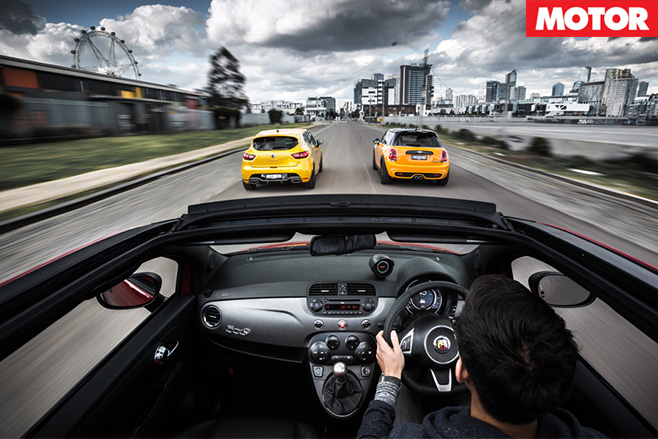
No such sweeping changes for the so-called “new” Abarth, here in the Enzo’s-on-speed-dial 595 Competizione convertible spec. Like its lesser Fiat 500-badged kin, the 2014 update is essentially a mild makeover of the old 1.4-litre turbo four-powered, dinky-sized device, the 595’s go-faster accoutrements blossoming the bottom line of the top-shelf rag-top to a whopping $39,000 in five-speed manual form (the Dualogic robotised manual adds $2000).
Our Renault Clio RS 200 EDC, in full-fat Cup Trophy form for $36,790, is vastly different to its predecessors, comes only six-speed dual-clutch-equipped and has five doors to its present rivals’ three apiece.
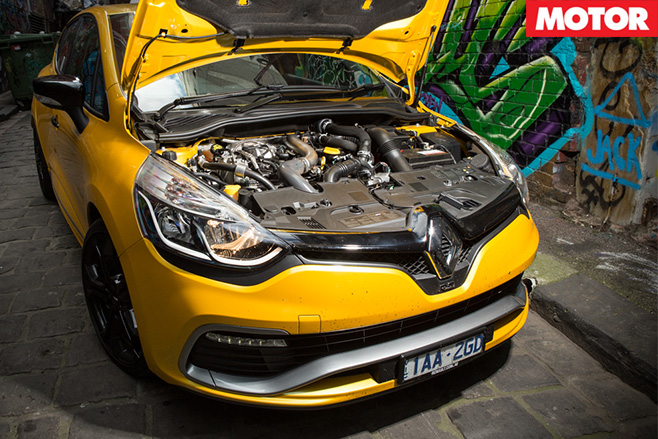
Inside, the Mini is clearly a car transformed. You sit lower, the far-set A-pillars add a newfound sense of roominess, and you really notice a lift in premium feel throughout a cabin that’s a little less kitschy and slightly more intuitive than its forebear.
It’s slicker than greased linoleum and the upsizing should please many buyers, though you sense that, somewhere, original Mini architect Sir Alec Issigonis is spinning in his grave.

Then you climb in the Abarth…
The big sweetener for the Competizione’s $3000 premium over the similarly potent Turismo version is the Corsa by Sabelt racing buckets, which look the duck’s gonads but are hard and flat-backed.

Seating-wise, you’re higher than a Keith Richards bender and the tiller, seat and pedal relationship seems sized for a small gorilla. The upside is that it permeates a strong sense of lighthearted fun that helps make every sprint to the shop for milk – or, perhaps, bananas – something of an event.
And that certainly seems the point of the Abarth experience. The dual-mode Record Monza exhaust will ring your bell as it howls, the taut Koni-enhanced suspension will scramble your brain and fuse your spine.
You’ll row furiously through the high-set gearstick trying to keep the little turbo four-pot in its useable 2500rpm sweet spot between peak torque (3000rpm) and Game Over (5500rpm). It’s a grin-pinning, though slightly masochistic, feel-good hoot.
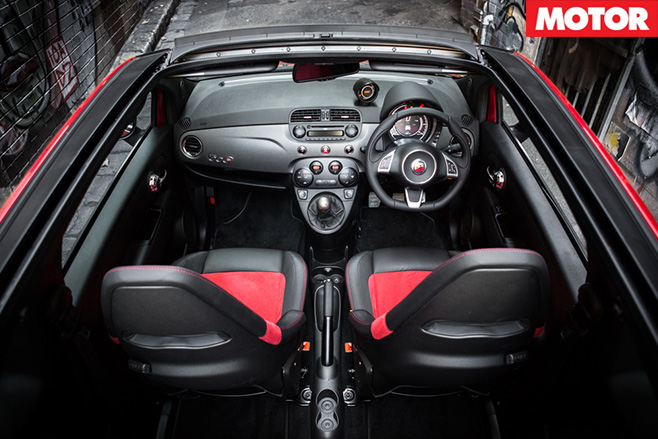
Launch control? Paddle shifts? Drive modes? Synthesised engine notes? The Clio’s no compact hot hatch by traditional thought, nor is its handy 6.7sec 0-100km/h time. Peak torque arrives at just 1750rpm and pulls stridently through to a 6000rpm redline, and while a little recalcitrant at the low-speed stuff, the dual-clutch is a responsive ally on the hunt. It’s a shame, though, Renault don’t offer a conventional manual transmission.
What’s quite convincing is the Clio’s sense of thoroughly modern, finely honed potency. It feels less like a steroid-fed grocery-getter and more like a shrunken performance car. The Mini, at 6.7sec 0-100km/h, is not only equally as quick to march, it feels keener again when let off its chain.
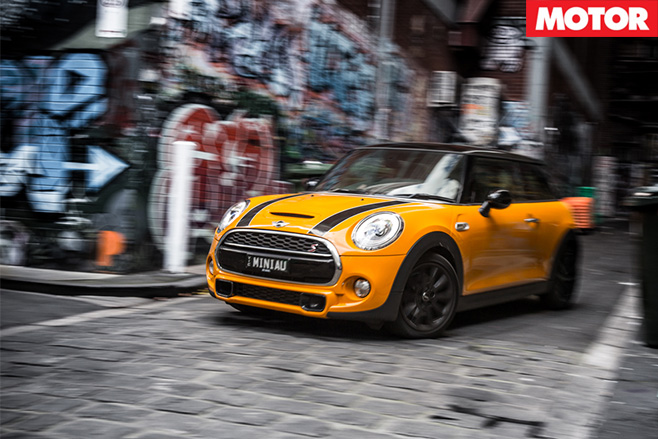
At a spirited, twisty back-road clip, the Mini and Abarth couldn’t feel more different. The former has lifted its game in blending bump compliance, chassis balance, agility and sharpness. It points confidently, is easy to place and rewards driver commitment with heady pace.
Meanwhile, the latter feels more agitated in character. The Abarth shimmies and shakes over road imperfections with more fuss and animation, its strident front-end grip tempered by noticeably slow steering to ease the tendency for the Italian, with its scant wheelbase, to throw itself off into the scenery. And all while you yell: “C’mon you bastard!” through silly grins and chattering teeth while the throttle’s pinned to the deck.
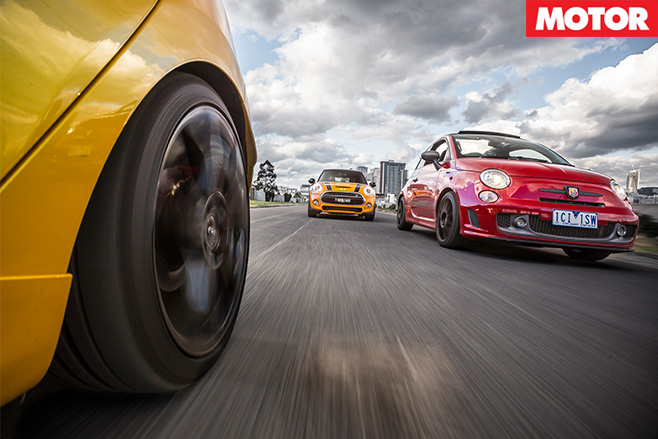
It’s a clear, accurate and quick corner-carving tool without histrionics or the need for manhandling. There’s a certain sweetness at play in the Clio – it’s both engaging and easily kept within its limits, which is a tough balance to strike.
Up to about eight-tenths pace – and for most driving below it – it’s the Mini’s game to lose. Its blend of refinement, premium feel, comfort, ride and on-demand pace is quite unprecedented for a car its size. This is a crucial point when considering the all-’round ownership experience.
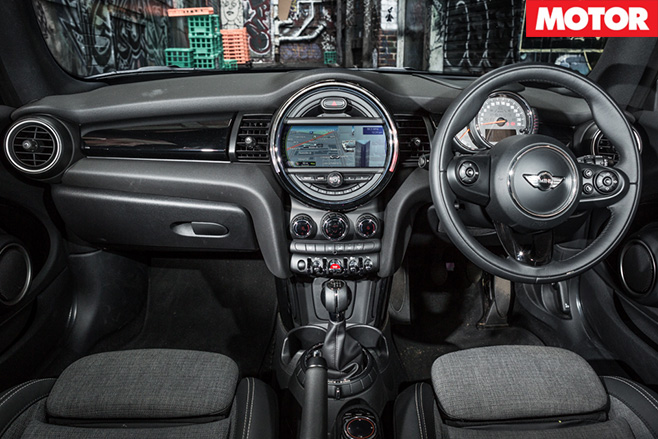
On a racetrack, that punchy 2.0-litre engine starts feeling flat in the top-end. But the major shortcoming is that the Mini seems to lose more of its sharpness and agility the closer it gets to its limits.
Lean hard into its 205mm 17-inch Hankooks and the Mini’s mass – a modest 1160 kilos, mind – takes over. It feels heavier and more ponderous than it ought to. That said, it’ll dance about playfully in the mid-corner provided you’re not grabbing its scruff too hard.
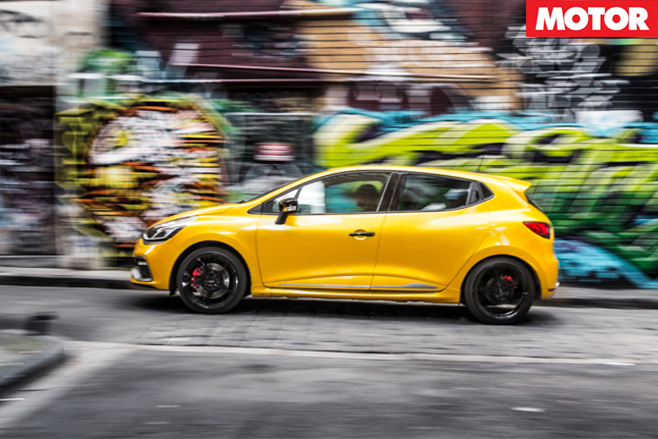
That the Clio offers the same rubber footprint as the Mini (albeit on 18-inch rims) makes us wonder how Renault Sport has managed to pry so much more talent from its steed once the red mist descends. Especially when, at 1218kg, the French car has the kerb-weight disadvantage.
Fire the featherweight (1035kg) Abarth as hard as you dare into a corner and that front end bites in fearlessly, its tail feels firmly planted and you need a big head of steam to get the chassis shimmying on a smooth circuit surface.
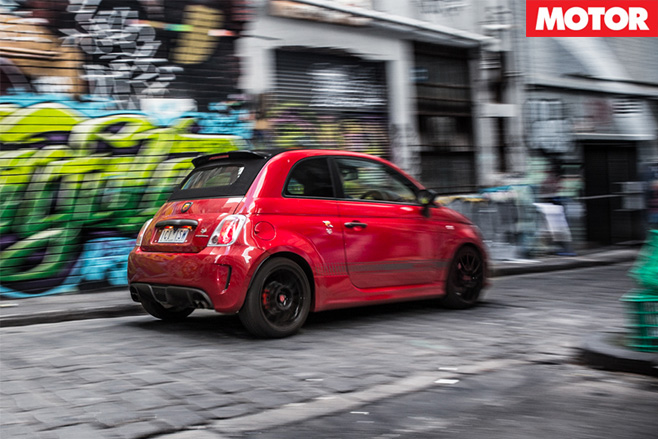
Even at its best, the Abarth is still the problem child: the gearshift is flaccid, the seats unsupportive laterally during hard cornering, and it requires a driving position that’ll have you booking a chiropractor after a handful of hot laps.
You could chalk up all of the Abarth’s shortcomings as ‘character’ if the 595 wasn’t so damn expensive. It’s a great third car, a weekend plaything, a pony with few tricks so impressive that you’d go there in a shot if the price tag wasn’t much beyond $20K. But anything the size of a shoebox asking nearly $40K should have a lot of all-’round talent, not just a few tricks up its sleeve during the occasional track day.

The Clio, though, has done much the same thing as its big brother Megane RS did to the regular (one size up) hatchback set; it’s introduced the soul and driving experience of a proper sports car into what would otherwise be a rather humdrum, predictable and sensible baby hatchback segment.
| u00a0 | u00a0 | Renault Clio RS 200 Cup Trophy | u00a0 | Mini Cooper S | u00a0 | Abarth 595C Competizione |
| u00a0 | u00a0 | u00a0 | u00a0 | u00a0 | u00a0 | u00a0 |
| Body | u00a0 | 5-door, 5-seat hatch | u00a0 | 3-door, 5-seat hatch | u00a0 | 3-door, 5-seat convertible hatch |
| Drive | u00a0 | front-wheel | u00a0 | front-wheel | u00a0 | front-wheel |
| Engine | u00a0 | 1618cc inline-4, DOHC, 16v, turbo | u00a0 | 1998cc inline-4, DOHC, 16v, turbo | u00a0 | 1368cc inline-4, DOHC, 16v, turbo |
| Bore/Stroke | u00a0 | 79.7 x 81.1mm | u00a0 | 82.0 x 94.6mm | u00a0 | 72.0 x 84.0mm |
| Compression | u00a0 | 9.5:1 | u00a0 | 11.0:1 | u00a0 | 9.8:1 |
| Power | u00a0 | 147kW @ 6000rpm | u00a0 | 141kW @ 6000rpm | u00a0 | 118kW @ 5500rpm |
| Torque | u00a0 | 240Nm @ 1750rpm | u00a0 | 280Nm (300Nm overboost) @ 1250rpm | u00a0 | 230Nm @ 3000rpm |
| Power/Weight | u00a0 | 121kW/tonne | u00a0 | 122kW/tonne | u00a0 | 114kW/tonne |
| Consumption | u00a0 | 6.3L/100km (claimed) | u00a0 | 5.9L/100km (claimed) | u00a0 | 6.5L/100km (claimed) |
| CO2 Emissions | u00a0 | 144g/km (claimed) | u00a0 | 138g/km (claimed) | u00a0 | 155g/km (claimed) |
| 0-100km/h | u00a0 | 6.7sec (tested) | u00a0 | 6.7sec (tested) | u00a0 | 8.6sec (tested) |
| Transmission | u00a0 | 6-speed dual-clutch | u00a0 | 6-speed manual | u00a0 | 5-speed manual |
| Weight | u00a0 | 1218kg | u00a0 | 1160kg | u00a0 | 1075kg |
| Suspension | u00a0 | struts, coil springs, anti-roll bar (f); torsion beam, coil springs, anti-roll bar (r) | u00a0 | struts, adjustable dampers, anti-roll bar (f); multi-links, adjustable dampers, anti-roll bar (r) | u00a0 | struts, coil springs, anti-roll bar (f); torsion beam, coil springs, anti-roll bar (r) |
| L/W/H | u00a0 | 4090/1732/1448mm | u00a0 | 3850/1727/1414mm | u00a0 | 3657/1627/1485mm |
| Wheelbase | u00a0 | 2589mm | u00a0 | 2495mm | u00a0 | 2300mm |
| Tracks | u00a0 | 1504/1500mm (f/r) | u00a0 | 1485/1485mm (f/r) | u00a0 | 1409/1402mm (f/r) |
| Steering | u00a0 | electrically-assisted rack-and-pinion | u00a0 | electrically-assisted rack-and-pinion | u00a0 | electrically-assisted rack-and-pinion |
| Brakes | u00a0 | 320mm ventialated discs, 2-piston calipers (f); 260mm discs, single-piston calipers | u00a0 | 295mm ventilated discs, single-piston calipers (f); 260mm solid discs, single-piston calipers (r) | u00a0 | 284mm ventilated discs, single-piston calipers (f); 240mm solid discs, single-piston calipers (r) |
| Wheels | u00a0 | 18 x 7.5-inch (f/r) | u00a0 | 17 x 7.0-inch (f/r) | u00a0 | 17 x 7.0-inch (f/r) |
| Tyres | u00a0 | 205/40 R18 Dunlop Sportmaxx RT (f/r) | u00a0 | 205/45 R17 Hankook Ventus S1 evo2 (f/r) | 205/40 R17 Michelin Pilot Exalto (f/r) | |
| Price | u00a0 | $36,790 | u00a0 | $36,950 | u00a0 | $39,000 |
| Price as tested | u00a0 | $37,540* | u00a0 | $42,160*u00a0 | u00a0 | $39,000 |
| u00a0 | u00a0 | *Renault Sport Signature colour ($750) | u00a0 | *DDC ($700); run-flat tyres ($260); reversing camera ($470); rear spoiler ($300); stripes ($200); anthracite roof lining $300); piano black interior ($250); LED headlights ($1200); sun protection ($400); HUD $700; DAB ($300); Nav Pro ($200); anti-dazzle mirror ($200) | u00a0 | u00a0 |
| Positives | u00a0 | Comes alive the harder you punt it; straight-line pace; looks | u00a0 | Bigger, classier and more useable than ever before; back-road ability | u00a0 | Likeable character; feisty engine; head-turning style |
| Negatives | u00a0 | Base RS is much better value; would be brilliant as a manual | u00a0 | Unsatisfying to drive really hard; traction issues | u00a0 | Awful ride; uncomfortable seats; handling difficulties; crazy priceu00a0 |






